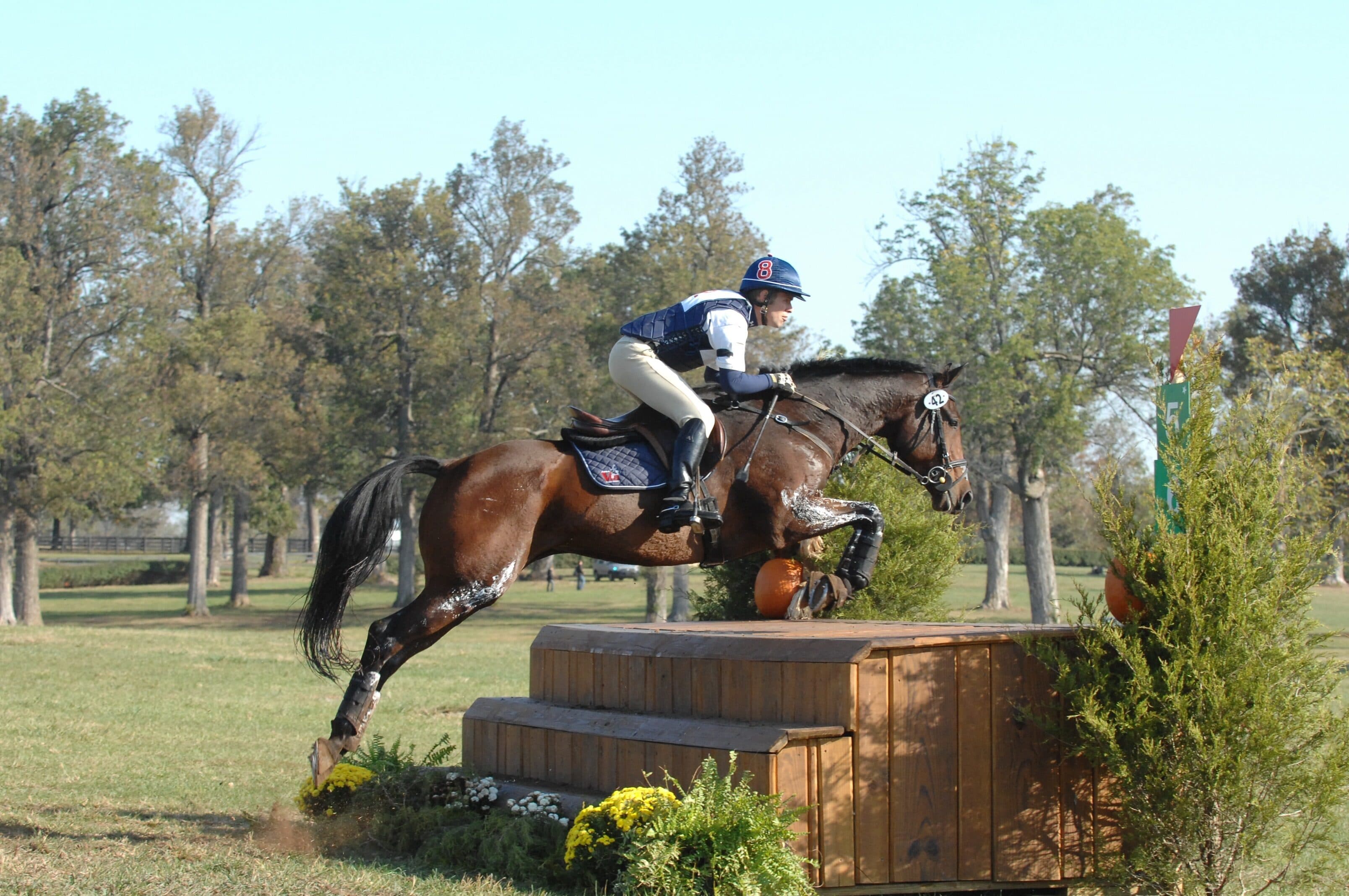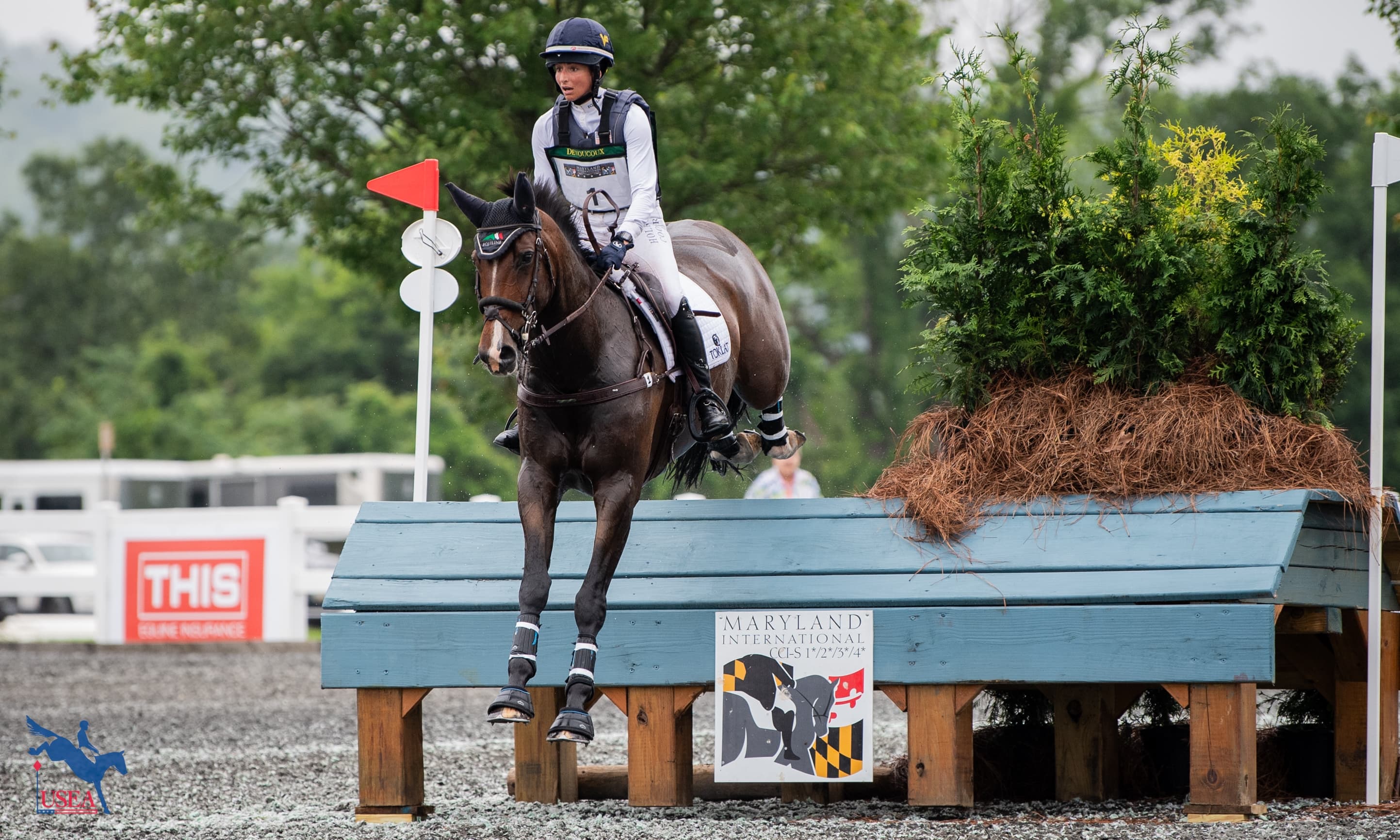by Kyle & Jackie Smith
I was lucky enough to have the opportunity to compete in the Hagyard CCI* at the KY Horse Park this past October in the traditional/classic (with steeplechase) format. I say lucky, because the first time I was at the KY Horse Park for the CCI * five years ago with my horse Summer’s Gift, aka Gus, he developed a hoof abscess the day of the first horse inspection and had to be withdrawn. The next year they had to cancel the steeplechase because they had gotten too much rain and the footing on the steeplechase was not safe. Since I had competed in the NAJYRC that summer with steeplechase I knew what we were missing and was really disappointed that the steeplechase was cancelled. I say lucky because after losing my good friend Gus to colic in the summer of ’07, a new horse, Stunt Pilot aka Jethro, came into my life with the ability to do a CCI*. I’m lucky to have a mother who could help keep my horse going for a couple of weeks while I was busy with school, not to mention doing all the braiding at the competition! I say lucky because I was inspired at an early age that doing a full format three-day event is something that event riders aspire to.(Kyle & Jethro competing at Hagyard CCI*. Photo courtesy of Xpress Foto.)
So when we got home my mom was bragging (you know how mothers can be) on how well Jethro and I had done at the Hagyard CCI*. It was a bit embarrassing but I must agree with her assessment of Jethro; he was awesome cross-country. She was a bit frustrated because, although everyone offered their congratulations, she got the feeling that they really didn’t quite ‘get it’- why was this competition such a big deal. So she wrote the following a letter and posted it on the WRPC & Tri-State Yahoo sites.
Some of you have asked what this CCI* competition is that Kyle competed in last weekend. The CCI is French ’Cours Complete Internationale’ or the ‘complete test’. This competition is conducted under FEI rules, the international governing organization of equestrian sports. The one star is run at the preliminary level although the show jumping is bigger, up to 3’9". You will hear them talk about the traditional/with steeplechase or the without steeplechase format. The traditional format cross-country day is a four phase competition that actually has been referred to as speed and endurance day. Phases A & C are called roads and tracks. Phase A is designed to warm your horse for phase B which is steeplechase and phase C which immediately follows B is designed to allow the horse to recover before the rigors of phase D the cross country. Between phase C & D there is a 10 minute vet box where they veterinarians check the horses’ vital statistics and check for soundness when they first come in the box and before they are allowed to start cross country. To give you a little better idea of all that is involved here are the speeds and distances that were run at the Hagyard CCI*.
Phase A: 3,520 meters this is 2.2 miles or more than twice the length of a Beginner Novice cross country course. The speed is 220mpm which is a trot, a brief canter to get ready for steeplechase and then some walk thrown in. After completing phase A there is 1 minute to check equipment before starting phase B. Optimum time on A is 16 minutes
Phase B: Steeplechase is 1,920 meters or 1.2 miles run at 640 mpm. Basically it is as long as a Novice cross country course run at nearly twice the speed of a Beginner Novice cross country course. The course this weekend was a figure eight course with 4 jumps on it but you jumped fences 1 & 2 twice for a total of 6 brush jumps that measure 4’7" in height with NO warm up fences!! Because the course is open and the fences are big and sloping it actually is fairly easy to make the time. You want to finish as close to the optimum time as possible (without going over) so that you don’t waste any of your horse’s energy while not accruing any penalties. Optimum time on B is 3 minutes.
Phase C: The second roads and tracks starts immediately as you go through the finish flags of B. This is a longer distance but slower time: 4000 meters, 2 1/2 miles @ 160mpm. Where as phase A was between 4 – 4 ½ minutes/kilometer, phase C is 6 minutes per kilometer. Near the finish of steeplechase there is an assistance area where you can give the rider a drink, give the horse a quick splash of water if needed and check shoes. There is a farrier there to quickly replace any lost shoes (you bring extras) if necessary. If the weather is hot they will also add a 5 – 10 minute box near the beginning of phase C to work on cooling the horses. Due to cool temps, that wasn’t necessary last weekend. The plan is to walk the first kilometer or so which will take longer than 6 minutes but once you pick up the trot you easily make up the time because horses easily trot at a pace 4 minutes / kilometer. So at 6 minutes/kilometer, that would get you into the vet box 1 minute early which will allow you an extra minute in the vet box. You don’t want to get in earlier than that because you would be going too fast and wasting your horse and, especially on a cool day, if you get into the vet box too early the horse may cool down too much and you’ll have to warm the horse up before they start cross country. Again that would be a waste of your horse. Optimum time is 25 minutes
10 minute box: The vet watches you trot through the finish flags to make sure the horse is sound. The rider gets off and the vet techs immediately record the vital statistics TPR (temperature, pulse, respiration). Because it was cool and Jethro came into the vet box with good stats we simply loosened his girth, put a halter on over his bridle and covered him with a honeycomb cooler and of course checked the shoes again. We did splash off his neck and chest but it really wasn’t necessary. There were 3 of us in the vet box and while Jane walked Jethro, Kyle and I chatted about how the course was riding and how Jethro was feeling. After approximately 5 minutes in the box they were ready to watch Jethro jog again. Of course, this being Jethro’s first CCI he didn’t know that he still had cross country to come. So when I jogged him up he was very mellow but as I jogged him back he caught sight of someone finishing cross-country and he perked right up. By now it was 3 minutes to go so we tightened the girth & I gave Kyle a leg up because he was getting antsy standing around with nothing to do. One final thing to do before he went over to the
start box: "grease". The horses are greased down from the forearm & the stifle to the fetlock. You hope you don’t need it, but the theory is that it you hit a fence the grease will help the horse slide over help to avoid a serious injury or fall.
Phase D – Cross Country – the cross country at a CCI especially one that was a championship like this one was is bigger, longer and more technical than the average horse trials course. The course was 3925 meters which is 2.45 miles and 3/4 to 1 mile longer than the average horse trials course. The speed is 520 mpm and the optimum time was 7 min and 31 sec. The normal horse trials course is 5 – 5 1/2 minutes. When Jethro saw the start box he seemed to think WOW, we get to jump more.
After D box: after completing D the horse is again checked for soundness and checking the vital statistics. The horses definitely came in here hot, sweaty, and blowing. It definitely required a lot of washing, scraping and repeating the process. After about 10 minutes the vets check you again and if they feel the horse is cooling off well enough you are the released to go back to the barn. If not you continue to work on cooling the horse until the vets are happy that the horse is ok.
So when you add it all together Kyle and Jethro logged 8.35 miles. They started phase A at 9:32 and finished cross country at about 10:34! I hope this gives you a little better understanding of what a CCI full format competition is. As we all say, "this ain’t no dressage show"! Although a better dressage score definitely would have helped J.
The full format CCI is educational for both horse and rider. If the rider has done their homework especially with the conditioning they have a great experience. The steeplechase gets both the horse and rider thinking "forward" they come out of the D box with increased confidence and in Jethro’s case, much more rideable.
The full format is no longer run above the one start level, but I think it is absolutely an essential part of the horses’ and riders’ education not to mention it is a real rush! For those who don’t see themselves ever being at the one star level, they now run full format competitions at the Training level.
Well to me the ‘big deal’ is that a traditional CCI is “the complete test”. Although I talked about luck earlier, it takes a lot more than luck to be ready for the “complete test”. Just as you have to prepare for tests in school you have to do your homework and prepare both you and your horse for the test. Like school,the ‘test’ measures what you have learned and how well prepared you are. Unlike school, at least for me, the journey is much more enjoyable but still hard work and the ‘test’ although a little nerve wracking is the most fun and rewarding experience I have had with my horses. Because I have prepared a horse for a traditional CCI* three times before it wasn’t quite as daunting but I was dealing with a new horse who has never done a CCI* before and we were still relatively new in our partnership.
Through the journey and time spent with my horse I learned so much about my horse that you just don’t get when preparing for your regular horse trials. In fact, all the horse trials were simply a means to an end and part of the preparation. I never wore a watch cross country until the CCI. I only wanted to be concerned with allowing my horse to go comfortably and learn his job at the Preliminary level. As we progressed through the season I asked him for a little more speed or make more efficient turns and he willingly answered my request. Now when I asked him to go slower at the last event before the CCI* because I wanted him to have an easy run, he wasn’t quite so willing. :)
I learned how to have a plan but how to be flexible in that plan. When the ground was too hard for gallops on a conditioning day we did lots of trotting up hills instead. I became more vigilant about everything about him. I became intimately familiar with every inch of his body and just what he liked and didn’t like. I learned something that no one can teach you, how to ‘feel’ what’s happening underneath you or to know the minute you walk in the barn if your horse just isn’t quite right. I’m not saying that you can’t learn these things without preparing for a CCI but it enables you to take your horsemanship and partnership with you horse to a level that I have not experienced in any other way.
At this time of year when you take the time to reflect on what you are thankful for I would like to take this opportunity to thank those who made this experience possible: the organizers Mary Fike, secretary Debbie Hinkle and all the volunteers who provide the venue for the CCI, Hagyard Equine Veterinary Hospital for their sponsorship, the USEF & USEA for their continued support of the traditional format and the National Jr/Young Rider Team Championships, all those who have helped and encouraged me along the way, Kim Meier for breeding a horse who literally has eventing in his blood, to Lisa Bezzeg who called us and said “I think I have ‘the horse’ for you” and to my parents for all their support. But most importantly I am grateful for my brave and generous horse. Now if he only liked dressage as well as jumping!
It is my hope that by sharing my story I may inspire some of you to aspire to ride in a classic CCI* someday and that you get to experience the “complete test” and all that goes with it. You may not have the horse right now or you may not be that far along in your riding career, but you have to have dreams and goals or you will never get there. Even if you aren’t ready yet or may never be ready please consider volunteering at a classic CCI so that this format will be available for all riders in the future. The CCI’s in the traditional / classic (with steeplechase) format are a thing of the past at the two star level and above and I fear that we are in danger of losing the traditional format at the one star level as well and that would be a great loss for all the upcoming young riders and their horses. And if that’s not enough to convince you to aspire to ride in a traditional CCI*; your horse will love you for it!! Jethro now thinks he is ‘hot stuff’ because he has passed “the complete test”!















